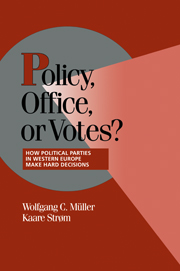Book contents
- Frontmatter
- Contents
- Figures
- Tables
- Contributors
- Chapter 1 Political Parties and Hard Choices
- Chapter 2 Office, Votes, and Then Policy: Hard Choices for Political Parties in the Republic of Ireland, 1981–1992
- Chapter 3 Party Behaviour and the Formation of Minority Coalition Governments: Danish Experiences from the 1970s and 1980s
- Chapter 4 From Policy-Seeking to Office-Seeking: The Metamorphosis of the Spanish Socialist Workers Party
- Chapter 5 Changing Strategies: The Dilemma of the Dutch Labour Party
- Chapter 6 Party Behavior in a Polarized System: The Italian Communist Party and the Historic Compromise
- Chapter 7 Decision for Opposition: The Austrian Socialist Party's Abandonment of Government Participation in 1966
- Chapter 8 Leadership Accountability and Bargaining Failure in Norway: The Presthus Debacle
- Chapter 9 Winner Takes All: The FDP in 1982–1983: Maximizing Votes, Office, and Policy?
- Chapter 10 Trade-offs in Swedish Constitutional Design: The Monarchy under Challenge
- Chapter 11 Parliamentary Rules and Party Behavior during Minority Government in France
- Chapter 12 Conclusions: Party Behavior and Representative Democracy
- Index
- Titles in the series
Chapter 3 - Party Behaviour and the Formation of Minority Coalition Governments: Danish Experiences from the 1970s and 1980s
Published online by Cambridge University Press: 05 May 2010
- Frontmatter
- Contents
- Figures
- Tables
- Contributors
- Chapter 1 Political Parties and Hard Choices
- Chapter 2 Office, Votes, and Then Policy: Hard Choices for Political Parties in the Republic of Ireland, 1981–1992
- Chapter 3 Party Behaviour and the Formation of Minority Coalition Governments: Danish Experiences from the 1970s and 1980s
- Chapter 4 From Policy-Seeking to Office-Seeking: The Metamorphosis of the Spanish Socialist Workers Party
- Chapter 5 Changing Strategies: The Dilemma of the Dutch Labour Party
- Chapter 6 Party Behavior in a Polarized System: The Italian Communist Party and the Historic Compromise
- Chapter 7 Decision for Opposition: The Austrian Socialist Party's Abandonment of Government Participation in 1966
- Chapter 8 Leadership Accountability and Bargaining Failure in Norway: The Presthus Debacle
- Chapter 9 Winner Takes All: The FDP in 1982–1983: Maximizing Votes, Office, and Policy?
- Chapter 10 Trade-offs in Swedish Constitutional Design: The Monarchy under Challenge
- Chapter 11 Parliamentary Rules and Party Behavior during Minority Government in France
- Chapter 12 Conclusions: Party Behavior and Representative Democracy
- Index
- Titles in the series
Summary
For more than two decades, all Danish governments were minority governments. Seven out of thirteen minority cabinets in the period from October 1971 to January 1993 – the period under scrutinity here – consisted of one party only, while six were minority coalition governments.
If we count the months these governments were in office, we get an almost identical picture: 47 per cent of the months saw a single-party minority government and 53 per cent a minority coalition government. During these many years, Denmark could be seen as a polity where both kinds of minority governments did occur to almost the same degree, the single-party variant being dominant during the 1970s and minority coalitions during the 1980s. The four-party majority coalition installed in January 1993 commanded only 50.3 per cent of the seats in parliament, and this only was a temporary deviation from the dominant pattern.
Thus, Denmark is obviously a case in point when Kaare Strøm challenges the conventional political science view of minority government and the formation of such governments. One of Strøm's conclusions in his book on minority government and majority rule reads:
Conventional explanations associate minority cabinets with political instability, fractionalization, polarization, and long and difficult formation processes. My results offer little support for these propositions. In fact, in some cases the data show the exact opposite to be true. My alternative explanation sees minority governments as consequences of rational party behavior under conditions of competition rather than conflict. On the whole, the data have given considerable support to this theory.
(Strøm 1990a: 89)- Type
- Chapter
- Information
- Policy, Office, or Votes?How Political Parties in Western Europe Make Hard Decisions, pp. 63 - 88Publisher: Cambridge University PressPrint publication year: 1999
- 8
- Cited by



